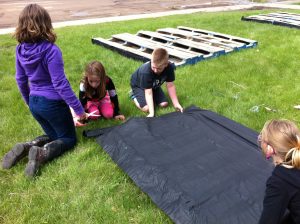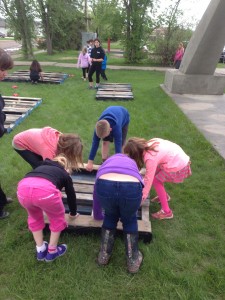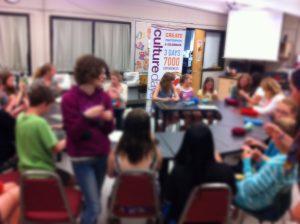When I tell people about the Lashburn School Garden, many ask “What does that have to do with art?” And while I do think there is an art to gardening, I divert the question to “intangible culture”.
During our Animateur Orientation, it was put forth that this year we might turn our focus to Intangible Culture — the invisible ‘stuff’ that makes up the visible, touchable ‘stuff’ of culture.
So, now the dialogue with students looks something like this:
I ask “What is Culture?”
They answer by giving me every example under the sun, but never actually define it.
I tell them they are all correct and that “Everything is Culture.”
I add the metaphor of a fish swimming in water. “Does it know it’s swimming in water? No. Just like you don’t know you are swimming in your own Culture.”
And now I further add “And how do the examples of Culture you provided come to be?” … “Who braided your hair this morning? How do they know how to braid?” … “Those home made cookies you have in your lunchbox? Who made them? Where did they get that recipe?” … “Who here knows how to ride a horse, or take care of a horse? Now how did you learn that?”
… And this is my segue into gardening. “How many of you have a garden at home?” 90% of the class raise their hands. “Who tends the garden?” They tell me. “Do they take an instruction manual?” A resounding “No.” “Well, then how do they know what they are doing? How do they walk out to garden patch and know what they are doing?”
And the light bulbs go off. I see a glimmer of understanding in their eyes…. That! is Intangible Culture.
I further this discussion with the students by telling them that for the duration of this project (and hopefully henceforth) they are going to start collecting Gardening Wisdom. They are going to start talking to the gardeners in their family and ask them for any ‘tips” that will help with the success of our garden.
I then supply a few examples from my (albeit limited) experience with gardening. I tell them about a second cousin (who is an incredible farmer) who only seeds by the moon. He suggests planting seeds on full moon, not because of the light (as most presume) but because of the full moon’s potential for drawing water to the surface of the earth. I tell them about the little old lady who took one look at my garden and asked “Where are the flowers? You need flowers so the pollinators come.” I tell them about the ‘three sisters’: how the First Nation people of Southern States have always grown corn, beans, and squash together. They do this because as the corn grows the beans wrap themselves around the stalk and flourish from the corn’s strength, and the squash spreads at the ground’s surface to protect the soil and plants from dehydration. I reiterate that certain plants like growing together and others do not. And we need to know this kind of information. So they need to ask the gardeners in their families.
We’ve started to collect these pearls wisdom on recipe cards, and I imagine that with time we will have quite the arsenal of Gardening Wisdom.
I end this conversation with the students of Lashburn by reiterating that we really are a Gardening Culture. “If I was in downtown Toronto,” I query, “how many kids would put up their hands when I ask who has a garden?” Not very many I suspect.
Although I think it is a right to be able to grow one’s own food, to have access to fresh, untampered pesticide-herbicide free food, it is fast becoming a privilege more than a right in this world. So I remind the students how important this is, that we preserve the Intangible Culture of Gardening.
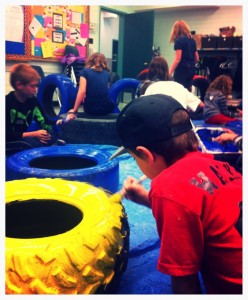
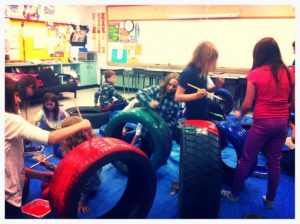
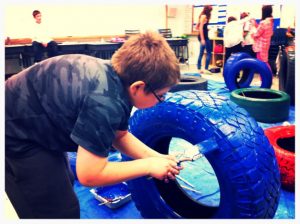 Yesterday and today we are painting tires!
Yesterday and today we are painting tires!


